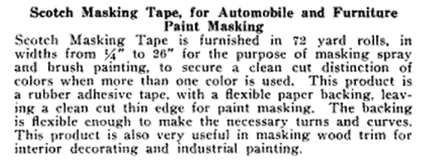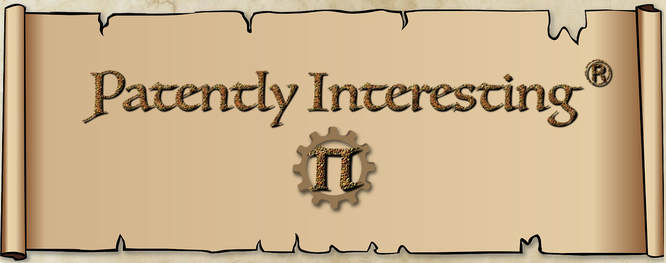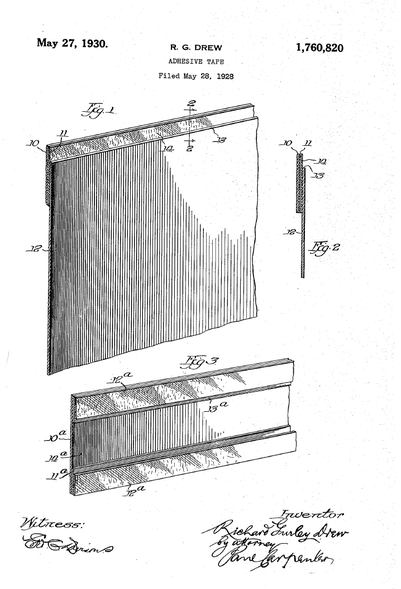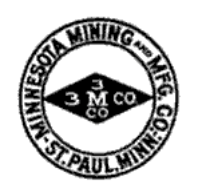 Masking Tape
Masking Tape
On May 27 of the year 1930, U.S. Patent No.: 1,760,820 issued to Richard Gurley Drew for "ADHESIVE TAPE". It was the first patent to issue for what is now commonly known as masking tape. Drew's inventive tape was one of the early developments that started the transformation of Minnesota, Mining & Manufacturing Company (now 3M) into a multinational conglomerate, known for it innovation.
Drew joined 3M in 1921, straight out of the University of Minnesota, where he studied chemical engineering. He was hired after he responded to an anonymous help-wanted advertisement with the humorous pitch: "if your company needs a pretty good banjo player with three semesters of college engineering, I am your man." Apparently, 3M recognized that Drew's clever response presaged an inventive spirit, which 3M was looking for. Indeed, 3M was starting to assemble a core group of scientists who could develop new products that 3M would then sell. Drew would be the third scientist hired by 3M.
Not long after joining 3M, Drew was tasked with developing a strong adhesive to better bind grit to the paper backing of sandpaper, which, at the time, was 3M's sole product. Drew experimented with hide glue, which was an animal glue created by prolonged boiling of animal connective tissue. Furniture makers and other manufacturers of wood products used hide glue to secure wooden pieces together. While quite effective in this application, hide glue was tricky to work with. If allowed to gel, hide glue would only form a weak adhesive. Apparently, this is what happened to Drew because the glue he formed was quite weak. However, it started Drew thinking.
From visiting auto body shops to see how 3M's sandpaper was performing, Drew knew that it was difficult to provide a car body with a two-tone paint job, which was becoming popular. More particularly, it was hard to form a clean and crisp cut line separating the two different color paints. Tape was being used to form the cut lines, i.e., to "mask" off one of the paints from the other. However, the tape that was being used was either a zinc oxide tape or a gummed paper tape. The zinc oxide tape was not water soluble and could only be removed with a hydrocarbon solvent, while the gummed paper tape was difficult to remove and often resulted in the marring of the underlying car body. Drew recognized that a masking tape with his weak adhesive was the solution.
Excitedly, Drew presented his invention to William McKnight, the president of 3M and his boss. McKnight was not impressed with Drew's invention and reminded Drew that he needed to complete his orginal task. Drew, however, did not give up. Instead, he worked on his invention after normal work hours. Once Drew had perfected his masking tape and demonstrated that there was a demand for it, McKnight quickly saw that he had made a mistake and embraced Drew's new product. 3M introduced the tape to the market in 1925, marketing it as "Scotch Masking Tape".
 Early Advertisement
Early Advertisement
3M filed a patent application for Drew's masking tape on July 27, 1925. Interestingly, this application did not form the basis (priority) for the '820 patent. In the 1925 patent application, the adhesive that was used was based on hide glue, which Drew had originally experimented with. By 1927, Drew had developed an improved adhesive that was instead based on plantation rubber. On April 11, 1927, 3M filed a patent application for masking tape with Drew's new rubber-based adhesive. The '820 patent would claim priority from this 1927 application and issue on May 27, 1930. The 1925 patent application issued almost two years later, on May 3, 1932, as U.S. Patent No.: 1,856,986. The delay in issuance was caused by a now disallowed procedure, which some applicants used as a delaying tactic. In this procedure, an applicant would not pay the issue fee for an allowed patent application, thereby causing the patent application to lapse. The applicant, however, would then "renew" the application by paying the issue fee just before the two-year anniversary of the application's allowance, resulting in the (delayed) issuance of the patent. Thus, while the '820 patent was the first patent for masking tape, it did not issue from the first patent application for masking tape.



